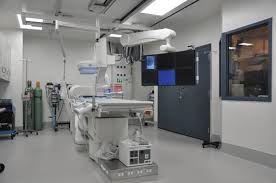- Translational Discovery Laboratory
Translational Discovery Laboratory
Director: Kevin Croce, MD,PhD (kcroce@partners.org)
Description: The Brigham and Women’s Hospital Translational Discovery Laboratory (formerly The Invasive Cardiovascular Experimental Laboratory) is a large animal translational research facility that focuses on developing novel therapies for human disease. The Translational Discovery Laboratory team works closely with investigators to design experiments, perform procedures, collect data, and harvest tissue. Services include consultation on experimental design, protocol submission, and direct management of procedures. The facility also functions as a physician training venue for novel medical devices.
Location: The Translational Discovery Laboratory encompasses 555 square feet of space at 221 Longwood Avenue and 1000 square feet of space at Mass College of Pharmacy. We have preferred access to the adjacent Harvard Medical School Conference Facility (http://www.theconfcenter.hms.harvard.edu/).
Major Equipment: GE Innova flat panel detector fluoroscopy system with hemodynamic and electrocardiographic monitoring systems, cardiovascular electrophysiology equipment for mapping and ablation, transthoracic echocardiography, intracardiac echocardiography, optical coherence tomography, access to adjacent research MRI facility.
Recent/Active Projects and Principle Investigators:
- Optimization of Optical Coherence Tomography and Fractional Flow Reserve Techniques- Croce
- Mechanisms of Vascular Repair Following Percutaneous Intervention- Croce
- Creation of a Model of Pulmonary Hypertension and Right Ventricular Failure- Croce
- Feasibility Testing of the Novel FlowTriever Pulmonary Embolectomy System in the Treatment of Pulmonary Embolism (PE) in a Large Animal Pig Model of PE- Croce
- Attenuation of Ischemia-reperfusion Injury in Limb Autographs Using an Extracorporeal Perfusion Device- Pomahac
- Branched Nerve Allografts to Improve Outcomes in Facial Composite Tissue Transplantation- Pomahac
- MRI-Guided Catheter Ablation of Cardiac Arrhythmias- Epstein
- Impact of Contact Force on Lesion Formation During Ventricular Ablation- John
- Role of contact force sensing in outflow tract ablation- John
- Ischemic Mitral Regurgitation: From Mechanism to Therapy- Levine
- Validation of dual PS-OCT (polarization sensitive optical coherent tomography) and IVUS (Intravascular ultrasound) catheter based system in swine- Nadkarni Completed Projects and Principle Investigators:
- Permanent Left Atrial Appendage Exclusion in Swine - Michaud
Deployment of polymeric stents for treatment of peripheral arterial disease – Welt - Impact of In-stent Restenosis on shear Stress and Athlerosclerotic Progression in the diabetic Swine – Welt
- Endovascular Suction Venous Thrombectomy (ESVT) – Welt,
- Evaluation of SDF-1 variants in a porcine ischemia reperfusion model – Welt,
- Feasibility Testing of Novel Non-Contact Mapping System to study the Heart’s Electrical Activity – John
- Feasibility Testing of Trans-Ventricular Septal pacing (TVSP) Through activation of the LV Septum Purkinje Fibers Via a Novel Procedure to Assess its Hemodynamic Effects and Myocardial Activation as Compared to Sinus Rhythm – Michaud
- Comparison of Epicardial and Endocardial ablation for Atrial Fibrillation – Michaud,
Cardiac Progenitor Cell Therapy for Advanced ischemic Cardiomyopathy - Welt - Development of a Device for Vascular Imaging and Crossing Total Arterial Occlusions – Welt
- The Effects of Diabetes On the Progression of Coronary Atherosclerosis in a Hypercholeserolemic Porcine Model – Welt
- Characterizing Swine Enhanced Radiofrequency (SERF) Ablations in Normal Swine – John
- Safety and Efficacy of catheter ablation on the epicardial versus the endocardial layers of the left ventricle in the swine heart – John
- Epicardial Pacing lead Placement Training Protocol – John

Getting Started:
Please email lfoley5@partners.org


